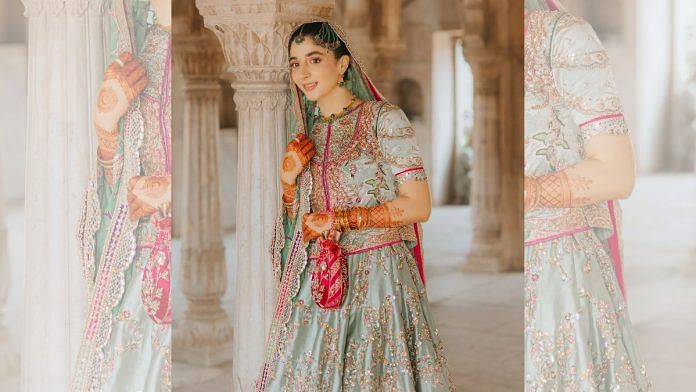New Delhi: Pakistanis are fiercely defending actor Mawra Hocane’s bridal lehenga after an Indian fashion commentator called it tacky. The lehenga had a distinct and fading textile art—chatapati craftsmanship—that was once worn by royalty in eastern India.
Sufi Motiwala called Hocane’s mint and fuschia ensemble ‘tacky and questionable’. In his Instagram video, he said, “This is what happens when you live in a world without Sabyasachi and Manish Malhotra [celebrated Indian couturiers]. The fabric choice is tacky.”
Motiwala’s comment on the choice of heritage fabric, which was handed down to the actor by her mother-in-law, didn’t go down well with many Pakistanis.
“Wow, I’m impressed. It takes a special kind of talent to be this cruel and this wrong,” Pakistani actor Nadia Afgan wrote. Pakistani stylist Zahra Sarfraz made an elaborate video to call Motiwala out.
“Sufi, what I don’t understand is we extend so much respect, love, and support your way. Why is it so difficult to extend the same respect towards us? What I find truly tacky is living outside the world of originality, sticking to two to three designers, making yourself feel better with that one label,” she said.
Shared history
While Motiwala swiftly deleted the video amid massive backlash, social media across India and Pakistan brought back the history of the textile, now found only in Lucknow.
The chatapati or tukri pattern dates back more than 300 years in ancient Awadh. Worn by nawabs, it is a technique where pieces of colourful fabrics are sewn together to form a gharara.
Though declining in Awadh and Rampur, the chatapati craft thrives in Pakistan, especially for wedding ceremonies.
Multiple videos on Instagram showed the intricate weaving and craftsmanship that goes into a chatapati gharara. Indian heritage storyteller Maroof Umar shared a video of a Lucknow-based Aamna Khatoon who has spent the last 40 years preserving the legacy of a chatapati gharara. The video, which garnered more than 5 lakh views, featured Khatoon talking about the dying art and her wish to pass it to the coming generations.
Even Pakistanis were quick to appreciate it.
Also read: Champions Trophy 2025 anthem has Atif Aslam & Indian flag. Pakistanis are proud of it
‘It’s a fad’
For Pakistanis, chatapati is a part of history and shared heritage.
“My family migrated from the eastern part of UP, my mother used to cut and sew chatapati, tukri and other cuts,” Karachi-based fashion designer Mohsin Sayeed told ThePrint. “She was an expert in it. She would hand-sew it. It would take months to prepare. The bridal ghararas would take even longer.”
Sayeed and his brother learnt the art from their mother.
“A chatapati gharara can be machine-made as well, but the hand-sewn ones have larger significance. I still use the older pieces sewn by my mother as references. We studied them, the cuts, the patterns. We deconstructed and then re-constructed it to keep the essence intact,” he added.
Sayeed noted that Awadh’s cultural influence remains strong in Urdu-speaking families, particularly in Karachi, where those who migrated from Lucknow and eastern UP preserved the tradition. However, he expressed concern that ghararas are now being “bastardised,” with little curiosity or understanding of the art form.
“Even in Pakistan now, not many know how to sew it. It is called gote, what people now call a flare and every gote takes extreme precision,” he said.
Sayeed also shared a personal anecdote about learning from older pieces, like the pattern from Muzaffar Ali Kotwara and his wife, Kaneez Wajib Khan Begum, passed down through generations.
He contrasted the fleeting fashion trends of today with the enduring cultural significance of such garments.
“There is no curiosity around art forms in this generation. This is merely a fad. It has come back. This is like the blouses that once were everywhere in Pakistan and then went away after Zia-ul-Haq banned it as Hindu attire—associated with India,” he said.
In Sayeed’s view, it remains uncertain whether Pakistan’s newfound appreciation for traditional forms will endure.
“The internet generation knows nothing about this [cultural significance of chatapati]. If you are in fashion, you learn and look at such forms. You collect history. Inn jahilon ko kya pata what an art form is (these uneducated folks know about the art form). Ghararas were worn by Fatima Jinnah, Shaukat Khanam. For them, you wear a fishtail gown and that’s fashion.”
(Edited by Prasanna Bachchhav)






